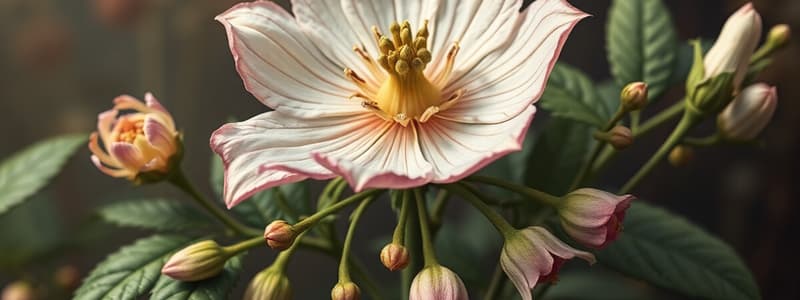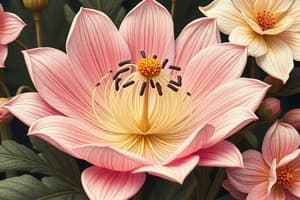Podcast
Questions and Answers
What is the term used to describe petals that are not fused together and remain distinct?
What is the term used to describe petals that are not fused together and remain distinct?
- Free (correct)
- Apetalous
- Valvate
- Imbricate
Which of the following terms refers to a flower structure that lacks petals?
Which of the following terms refers to a flower structure that lacks petals?
- Campanulate
- Wanting (correct)
- Imbricate
- Gamopetalous
Which term describes petals that touch each other at their margins?
Which term describes petals that touch each other at their margins?
- Funnelform
- Valvate (correct)
- Apetalous
- Bilabiate
What does the term 'Bilabiate' describe in floral structure?
What does the term 'Bilabiate' describe in floral structure?
Which shape best describes a corolla that resembles a bell?
Which shape best describes a corolla that resembles a bell?
What term describes flowers that lack one or two whorls?
What term describes flowers that lack one or two whorls?
In which flower type are the calyx, petals, and stamens attached to the receptacle below the ovary?
In which flower type are the calyx, petals, and stamens attached to the receptacle below the ovary?
Which flower type has all four whorls present?
Which flower type has all four whorls present?
What is the arrangement called when the perianth and stamens are attached halfway to the ovary?
What is the arrangement called when the perianth and stamens are attached halfway to the ovary?
Which type of symmetry does an asymmetrical flower exhibit?
Which type of symmetry does an asymmetrical flower exhibit?
What does a floral diagram begin with in the representation of a flower?
What does a floral diagram begin with in the representation of a flower?
Which of the following correctly describes the cyathium inflorescence?
Which of the following correctly describes the cyathium inflorescence?
In a floral diagram, how is the number of flower parts indicated when they are united or fused?
In a floral diagram, how is the number of flower parts indicated when they are united or fused?
What term is used to describe an inflorescence where branches start from different points and reach the same level?
What term is used to describe an inflorescence where branches start from different points and reach the same level?
Which part of the flower is represented by the symbol 'G' in floral diagrams?
Which part of the flower is represented by the symbol 'G' in floral diagrams?
What type of ovule is characterized by being curved with a micropyle that nearly meets the funiculus?
What type of ovule is characterized by being curved with a micropyle that nearly meets the funiculus?
Which type of placentation has ovules attached to the center or axis of the ovary?
Which type of placentation has ovules attached to the center or axis of the ovary?
What describes free-central placentation?
What describes free-central placentation?
What type of inflorescence has the oldest flower at the terminal part of the main axis?
What type of inflorescence has the oldest flower at the terminal part of the main axis?
In which type of inflorescence do the youngest flowers appear at the terminal end of the floral axis?
In which type of inflorescence do the youngest flowers appear at the terminal end of the floral axis?
What type of placentation is indicated by ovules attached at the bottom of a unilocular ovary?
What type of placentation is indicated by ovules attached at the bottom of a unilocular ovary?
Which of the following types of placentation involves ovules attached to the walls of the ovary?
Which of the following types of placentation involves ovules attached to the walls of the ovary?
What distinguishes a cyme from a corymb in floral arrangement?
What distinguishes a cyme from a corymb in floral arrangement?
What do you call the minute opening in the ovule where the pollen tube enters during fertilization?
What do you call the minute opening in the ovule where the pollen tube enters during fertilization?
Which term describes an ovule that has turned 180° during its development?
Which term describes an ovule that has turned 180° during its development?
What is the term for a pistil with multiple carpels?
What is the term for a pistil with multiple carpels?
Which part of the pistil is responsible for receiving pollen?
Which part of the pistil is responsible for receiving pollen?
What is a compound pistil characterized as?
What is a compound pistil characterized as?
What is the function of the placenta in the ovary?
What is the function of the placenta in the ovary?
What describes a pistil that has no style?
What describes a pistil that has no style?
What does 'superior ovary' refer to in floral structure?
What does 'superior ovary' refer to in floral structure?
What does it mean if stamens are described as being introrse?
What does it mean if stamens are described as being introrse?
Which of the following accurately describes monadelphous stamens?
Which of the following accurately describes monadelphous stamens?
What characterizes a staminode?
What characterizes a staminode?
In which condition are anthers described as syngenesious?
In which condition are anthers described as syngenesious?
What does the term 'versatile' refer to in terms of anther structure?
What does the term 'versatile' refer to in terms of anther structure?
Which term describes a structure that bears both the gynoecium and androecium?
Which term describes a structure that bears both the gynoecium and androecium?
What does it mean when a flower has apocarpous gynoecium?
What does it mean when a flower has apocarpous gynoecium?
What is indicated by the term tetradynamous in a flower?
What is indicated by the term tetradynamous in a flower?
Flashcards
Complete Flower
Complete Flower
A flower that has all four whorls: sepals, petals, stamens, and pistil.
Incomplete Flower
Incomplete Flower
A flower lacking one or two whorls (sepals, petals, stamens, or pistil).
Hypogynous Flower
Hypogynous Flower
A flower where the calyx, petals, and stamens are attached to the receptacle below the ovary.
Perigynous Flower
Perigynous Flower
Signup and view all the flashcards
Asymmetrical Flower
Asymmetrical Flower
Signup and view all the flashcards
Free
Free
Signup and view all the flashcards
Imbricate
Imbricate
Signup and view all the flashcards
Valvate
Valvate
Signup and view all the flashcards
Apetalous
Apetalous
Signup and view all the flashcards
Bilabiate
Bilabiate
Signup and view all the flashcards
Funiculus
Funiculus
Signup and view all the flashcards
Style
Style
Signup and view all the flashcards
Ovary
Ovary
Signup and view all the flashcards
Micropyle
Micropyle
Signup and view all the flashcards
Placenta
Placenta
Signup and view all the flashcards
Nucellus
Nucellus
Signup and view all the flashcards
Simple Pistil
Simple Pistil
Signup and view all the flashcards
Compound Pistil
Compound Pistil
Signup and view all the flashcards
Filament
Filament
Signup and view all the flashcards
Anther
Anther
Signup and view all the flashcards
Monadelphous
Monadelphous
Signup and view all the flashcards
Monandrous
Monandrous
Signup and view all the flashcards
Versatile
Versatile
Signup and view all the flashcards
Staminode
Staminode
Signup and view all the flashcards
Syngenesious
Syngenesious
Signup and view all the flashcards
Androgynophore
Androgynophore
Signup and view all the flashcards
Corymb or Corymbose Inflorescence
Corymb or Corymbose Inflorescence
Signup and view all the flashcards
Cyathium
Cyathium
Signup and view all the flashcards
Floral Diagram
Floral Diagram
Signup and view all the flashcards
Internal Morphology
Internal Morphology
Signup and view all the flashcards
Pendulous and Deciduous Inflorescence
Pendulous and Deciduous Inflorescence
Signup and view all the flashcards
Campylotropous Ovule
Campylotropous Ovule
Signup and view all the flashcards
Orthotropous Ovule
Orthotropous Ovule
Signup and view all the flashcards
Placentation
Placentation
Signup and view all the flashcards
Axile Placentation
Axile Placentation
Signup and view all the flashcards
Basal Placentation
Basal Placentation
Signup and view all the flashcards
Free-central Placentation
Free-central Placentation
Signup and view all the flashcards
Marginal/Ventral Placentation
Marginal/Ventral Placentation
Signup and view all the flashcards
Parietal Placentation
Parietal Placentation
Signup and view all the flashcards
Study Notes
Flower Morphology
- Flowers are the major diagnostic feature of angiosperms
- Flowers are determinate, unlike vegetative shoots
- Flowers have four primary parts: sepals, petals, stamens, and carpels
- Pedicel: the flower stalk
- Bract: usually a reduced leaf, often found on the side of the pedicel
- Receptacle: the part of the flower to which other parts attach
- Perianth: the outermost non-reproductive whorl of modified leaves
- Calyx: the collective term for sepals
- Tepals: undifferentiated perianth parts; a term used when sepals and petals are similar
- Sepals: individual members of the calyx. Frequently form a whorl next to the involucre, if present.
- Corolla: inner whorl of modified leaves; usually colorful
- Petals: individual parts of the corolla; attract pollinators
- Androecium: all male parts of the flower, collectively the stamens
- Gynoecium: female parts of the flower, collectively the carpels
Flower Symmetry
- Symmetrical: floral organs are the same in number. This can be:
- Actinomorphic: multiple planes of symmetry
- Biradial: two planes of symmetry
- Zygomorphic: one plane of symmetry
- Asymmetrical: lacks any plane of symmetry
Types of Flowers
- Perfect (Bisexual or Hermaphrodite): contains both stamens and pistils
- Imperfect (Unisexual): contains either stamens or pistils only
- Pistillate: flowers with only pistils
- Staminate: flowers with only stamens
Flower Insertion
- Epigynous: sepals, petals, and stamens seemingly arise atop a small, inferior ovary
- Hypogynous: sepals, petals, and stamens arise at the base of a superior ovary
- Perigynous: sepal, petal, and stamen attachments form a floral cup/hypanthium around the ovary (the ovary is referred to as half-inferior, or half-superior, depending on how high or low it is located)
Variation in the Calyx
- Sepals can have various shapes and may or may not be fused together. These variations include:
- Free (Polysepalous or Chorisepalous): separate sepals
- Fused (Gamosepalous): fused (united) sepals.
- Scabrous: rough sepals
- Tubular: fused sepals in a tube shape
Variation in the Corolla
- Corolla can have various shapes and may or may not be fused together. These variations include:
- Apetalous: lacking petals
- Bilabiate: two-lipped at rim
- Campanulate/Funnel-shaped/Funnelform: a bell-shaped or funnel-shaped corolla
- Gamopetalous/Sympetalous: united petals
- Bilobate: two-lobed corolla
Variation in the Androecium
- Androphore: stalk of a group of stamens
- Anemophilous: wind-pollinated plants
- Stamen Morphology: stamen can be:
- Sessile: lacking a filament
- Basifixed: Anther attached to base of the filament
- Dorsifixed: Anther attached to the side of the filament
- Epipetalous: stamens attached to the petals
- Exserted: filaments extended outside perianth
- Extorse: anthers turned outward
- Filament: the stalk of the anther
Variation in the Gynoecium
- Androgynophore: a stalk-like structure bearing the androecium and gynoecium
- Apocarpous: having one or more separate pistils
- Carpel/Locule: a simple pistil (a hollow cavity); the chambers in an ovary
Variation in Flower Parts
- Parts may be united or separate (i.e., stamens, carpels)
- A mass of pollen grains (in cases such as pollination)
- Staminal column: a floral tube of united filaments
- Staminodes: sterile stamens
- Various insertion types.
Placentation
- Axile: ovules attached to the central axis of the ovary
- Basal: ovules attached to the base of the ovary
- Free-central: ovules attached to the central column (stalk) of an unilocular ovary
- Marginal/ventral: ovules attached to the sides of the ovary
- Parietal: ovules attached to the ovary wall
Studying That Suits You
Use AI to generate personalized quizzes and flashcards to suit your learning preferences.
Related Documents
Description
Test your knowledge on the morphology and symmetry of flowers, key features of angiosperms. This quiz covers essential terms and parts of flowers, including sepals, petals, stamens, and carpels. Dive into the fascinating structures that contribute to flower uniqueness and reproductive strategies.




